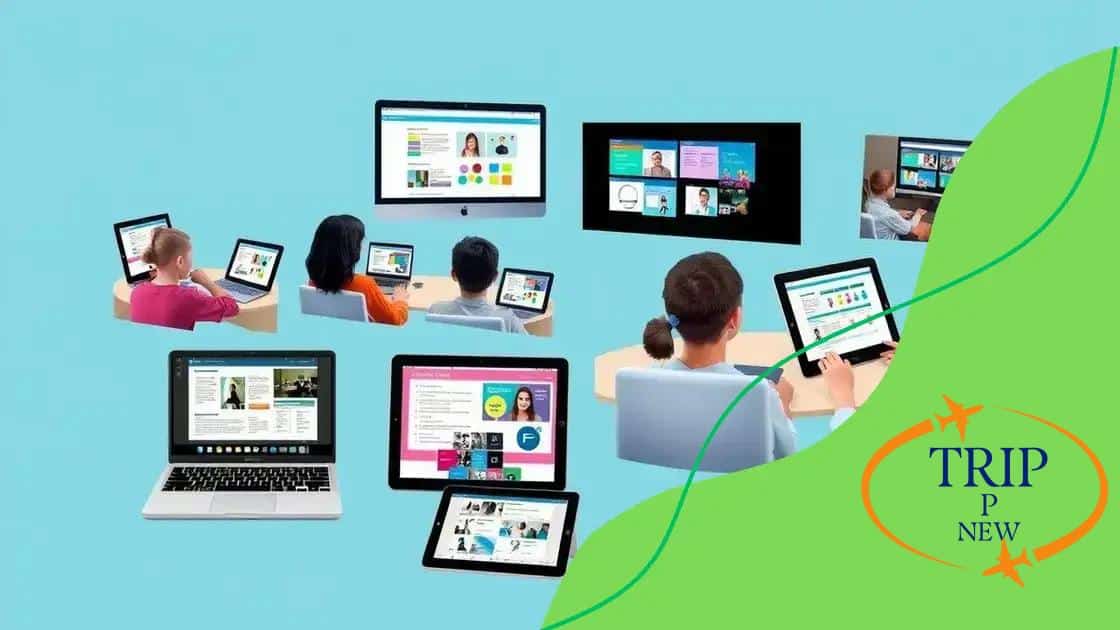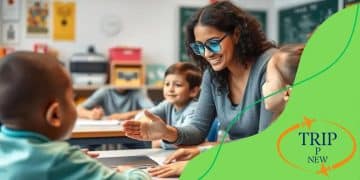The impact of virtual classrooms on student collaboration

Anúncios
The impact of virtual classrooms on student collaboration includes enhanced interaction, personalized learning opportunities, and the development of important skills, while also presenting challenges such as communication barriers and feelings of isolation.
The impact of virtual classrooms on student collaboration is becoming increasingly significant in today’s educational landscape. Have you ever wondered how online learning environments shape teamwork among students? Let’s dive into this intriguing topic.
Anúncios
Understanding virtual classrooms
Understanding virtual classrooms is essential in today’s digital age. These online environments offer students a unique way to learn and engage with material. They replicate traditional classroom settings but provide the flexibility to study from anywhere, making education more accessible.
What are Virtual Classrooms?
A virtual classroom uses technology to facilitate learning. Here, students can interact with instructors and classmates through video, chat, and shared documents. This model breaks geographical barriers, transforming how students connect.
Key Features of Virtual Classrooms
- Real-time interaction with teachers and peers.
- Access to a variety of learning materials.
- Flexible scheduling for lessons and assignments.
In a virtual classroom, students often participate in discussions and group projects, enhancing their learning experience. These collaborative efforts improve understanding and retention of concepts. The use of digital tools, such as forums and breakout rooms, helps foster teamwork.
Anúncios
Benefits
The benefits of virtual classrooms are numerous. They offer personalized learning paths, allowing students to work at their own pace. This flexibility helps students balance education with other commitments. Furthermore, these environments encourage the development of technical skills, which are invaluable in today’s workforce.
Many students find that the online format allows for a deeper engagement with the material. They can explore resources outside of standard textbooks, using multimedia and interactive content. This engagement is critical in maintaining motivation and enthusiasm for learning.
Benefits of collaborative learning
The benefits of collaborative learning in virtual classrooms are substantial and can significantly enhance the educational experience for students. When learners work together, they develop skills that are valuable both academically and personally.
Improved Academic Performance
One of the striking advantages of collaborative learning is improved academic performance. Students often understand complex concepts better when they can discuss and work through problems with their peers. This approach encourages deeper engagement and retention of knowledge.
Development of Communication Skills
Through collaborative learning, students refine their communication skills. They learn how to articulate their thoughts clearly and listen to others effectively. This exchange of ideas fosters a supportive learning environment where every voice is valued.
- Collaboration encourages feedback.
- Students practice active listening.
- They express their perspectives confidently.
In addition to communication, teamwork is a critical skill developed through collaboration. Students learn to share responsibilities and leverage each other’s strengths. This is particularly important in today’s interconnected world, where many jobs require working in teams.
Boosting Confidence and Motivation
When students collaborate, they often feel more confident in their abilities. Sharing ideas and receiving encouragement from peers can inspire them to take risks in their learning. This increased motivation leads to greater participation and enthusiasm in educational activities.
Moreover, working with classmates helps create a sense of community. Students feel they are not alone in their educational journey, which can reduce feelings of isolation often associated with virtual learning. This supportive network enhances their overall learning experience.
Tools that facilitate student interaction

Tools that facilitate student interaction are vital in virtual classrooms. These resources not only enhance communication but also promote collaboration among students. Understanding the different tools available can significantly improve the learning experience.
Popular Tools for Interaction
Many tools exist that help create an engaging learning environment. Some of the widely used platforms include:
- Zoom: A video conferencing tool that allows live discussions and group work.
- Google Classroom: This platform helps organize assignments and facilitates easy feedback.
- Microsoft Teams: Combines chat, video, and file-sharing features to enhance teamwork.
- Miro: An online whiteboard that encourages brainstorming and visual collaboration.
These tools make it easy for students to share ideas and work together on projects. For example, in a Zoom meeting, students can break into smaller groups to discuss topics, which promotes active participation. This type of interaction fosters a sense of community, even in a virtual setting.
Enhancing Engagement
Using interactive tools can also boost student engagement. Features like polls, quizzes, and breakout rooms create opportunities for students to participate. With tools like Kahoot!, teachers can turn learning into a fun game format that encourages students to be involved.
Additionally, chat functions allow students to ask questions in real-time, enabling immediate support. This instant communication is crucial for maintaining the flow of the lesson and encouraging students to express their thoughts without hesitation.
Challenges of virtual collaboration
Virtual collaboration presents unique challenges that can affect student learning experiences. Understanding these obstacles is crucial for both educators and learners to navigate the virtual classroom effectively.
Communication Barriers
One challenge is the potential for miscommunication. In a digital environment, verbal and non-verbal cues may be missed. This can lead to misunderstandings among students. Tone can be hard to interpret through text or even video, making it essential for students to be clear with their messages.
Technical Issues
Technical difficulties can also disrupt the flow of collaboration. Issues such as poor internet connectivity, software glitches, or unfamiliarity with technology can hinder participation. These problems can frustrate students, leading to decreased motivation. To mitigate these issues, schools often provide training on the tools used in virtual classrooms.
- Ensure strong internet connection.
- Familiarize students with technology.
- Provide tech support during sessions.
Moreover, lack of access to necessary devices can create division among students. When some learners are unable to connect due to hardware limitations, the collaboration experience becomes uneven.
Feelings of Isolation
Another significant challenge is the feeling of isolation. Although students are engaging through screens, the lack of physical presence can make them feel disconnected from their peers. This can affect their overall engagement and enthusiasm.
To combat these feelings, teachers can create opportunities for informal interactions. Group activities and social breaks during sessions can help build community among students, fostering relationships that are often lacking in virtual settings.
Future trends in online education
The future of online education promises exciting changes that will enhance learning experiences for students. As technology evolves, educators are finding new ways to engage students in virtual classrooms.
Increased Use of Artificial Intelligence
One major trend is the increasing use of artificial intelligence (AI) in education. AI tools are helping to personalize learning experiences. For example, platforms can analyze student performance and provide customized resources to fit their needs. This tailored approach helps to ensure that no student is left behind.
Enhanced Interaction Through Virtual Reality
Another future trend is the adoption of virtual reality (VR) in online education. VR allows students to immerse themselves in a learning environment that feels real. For example, history students can explore ancient civilizations, while science students can conduct virtual lab experiments. This level of engagement can significantly improve understanding and motivation.
- Immersive learning experiences.
- Real-life simulations for practice.
- Increased student enthusiasm for subjects.
Additionally, gamification is set to play a larger role in online learning. By incorporating game-like elements, such as points and rewards, educational platforms can motivate students to participate and achieve their goals.
Flexible Learning Options
The future of online education will also focus on flexibility. Hybrid models combining in-person and online learning are becoming popular. This approach allows students to choose when and how they learn, catering to diverse needs and lifestyles.
Furthermore, lifelong learning will be emphasized, as adults seek to upskill or change careers. Online platforms are increasingly offering short courses and certifications that allow for easy access to learning at any stage of life.
FAQ – Frequently Asked Questions about Virtual Classrooms and Student Collaboration
What are virtual classrooms?
Virtual classrooms are online learning environments where students and teachers interact through video, chat, and shared resources.
How do virtual classrooms enhance student collaboration?
They provide tools for real-time interaction, group projects, and discussions, promoting teamwork and communication among students.
What challenges do students face in virtual collaboration?
Common challenges include technical issues, communication barriers, and feelings of isolation, which can hinder effective teamwork.
What are the future trends in online education?
Future trends include the use of artificial intelligence for personalized learning, increased adoption of virtual reality, and flexible hybrid learning models.





